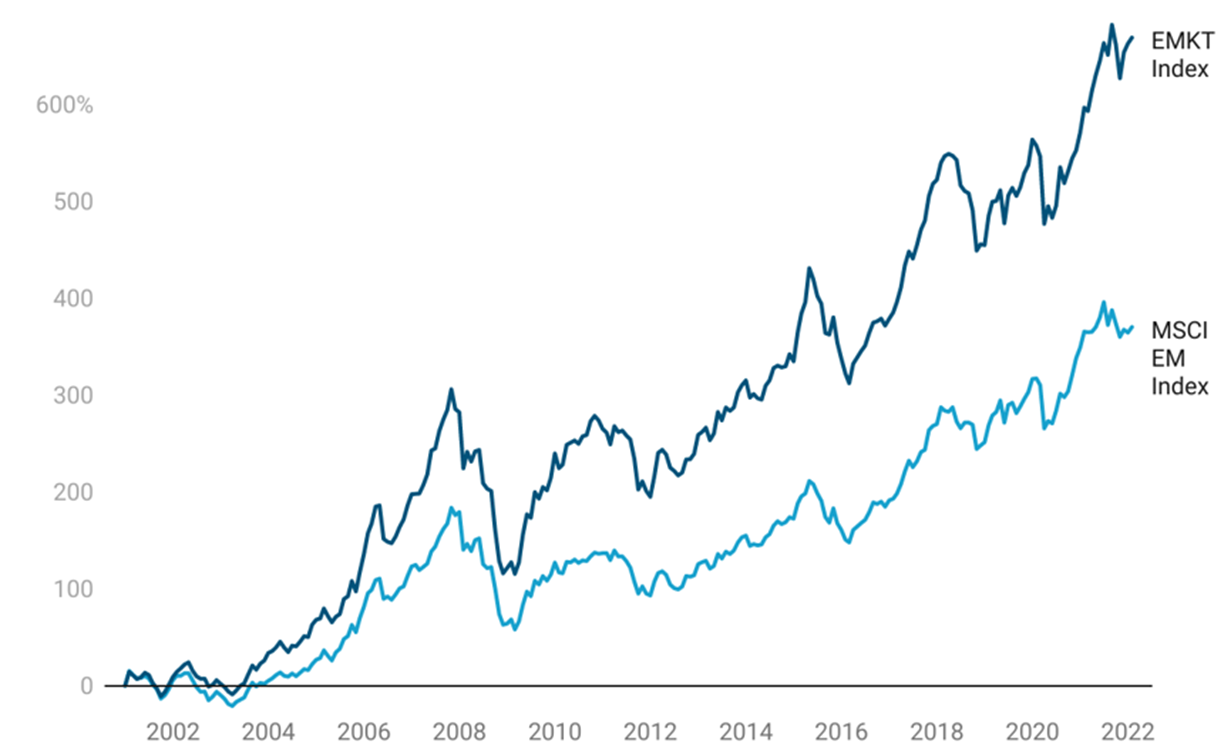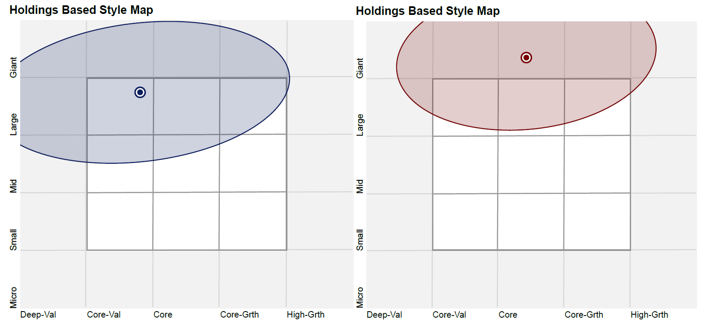Expert Analysis: Emerging Markets
Investors have long been attracted to emerging markets for their potential growth. Emerging markets have large, increasingly affluent, generally younger, populations. Emerging markets, too, have been at the forefront of innovation with some of the fastest growing technology firms listing on emerging market exchanges, Taiwan Semiconductor Manufacturing being a prime example. However, investing in emerging markets can be risky. That is why it is prudent to take the right approach. Here we provide some insightful analysis for our popular Multifactor Emerging Markets Equity ETF (EMKT) versus the emerging markets benchmark.
Australian investors have been investing offshore for some time and the rise of ETFs has increased the opportunity set and further expanded the investment landscape. Investing in emerging markets makes sense. Emerging markets have been a key contributor to global growth. According to the IMF, emerging markets contribute more the global GDP than developed economies. Additionally emerging markets are associated with sizable populations that are becoming increasingly affluent. 87% of the world’s population is in emerging and developing markets. 77% of the world’s population between 15 and 24 years olds live in emerging markets and it is these consumers of the future that are driving growth in some of these markets. As technology improves, many of the economies are undergoing fundamental shifts.
Despite these favourable demographics and growth potential, many Australian investors do not have an exposure to emerging markets. Being selective in emerging market equities is important. Not all of emerging market companies are desirable from an investment standpoint, many are state owned enterprises and inefficiencies allow astute investors to take advantage of mispricing.
Importantly when investing in emerging markets there are other risks to consider such as currency, geo-political, economic, market and sector risks.
To date there has only been two popular approaches to investing in emerging market equities:
- Via an actively managed fund; or
- Via a passive fund tracking the benchmark index.
Investing in emerging markets is associated with being expensive because brokerage fees are higher and they require more specialist knowledge, so many investors have been happy to pay higher fees to have a professional investor select the best emerging markets opportunities. Sometimes the returns were good, but often they were not. Many people found this a poor bargain and moved to lower cost passive funds that tracked traditional indices. In these new funds, returns could be thought of as average - not high, not low, just the market average.
When it comes to emerging market equity investing in a passive fund, the widely used benchmark is the MSCI Emerging Markets Index, for ease of reading let’s call it the MSCI EM Index. Innovations in index design for passive funds are delivering above market benchmark returns over the long term while retaining low costs. It is this approach VanEck offers in emerging market equities and it is being used by savvy investors as a substitute for both.
VanEck MSCI Multifactor Emerging Markets Equity ETF (ASX: EMKT) tracks the MSCI Emerging Markets Diversified Multiple-Factor Index (EMKT Index) and it provides investors with diversified access to companies that demonstrate four factors: Value, Momentum, Low Size and Quality. Factors are identifiable, persistent drivers of risk and return.
Taking a diversified approach across factors has been proven to produce outperformance over the long-term compared to a benchmark market capitalisation approach in emerging markets.
So let’s walk through the difference between EMKT and its index and the MSCI EM Index.
EMKT vs MSCI EM Index – Fundamentals
|
|
|
|
|
Index strategy |
Smart beta |
Market capitalisation weight |
|
Number of countries |
22 |
33 |
|
Number of sectors |
11 |
11 |
|
Number of holdings |
246 |
~2500 |
|
12mth trailing Dividend Yield |
3.37% |
2.40% |
|
Dividend frequency |
Annually |
- |
|
ROE (%) |
16.91 |
14.51 |
|
Hist 3Yr EPS Growth |
13.0 |
11.9 |
|
Hist 3 Yr Sales Growth |
9.4 |
13.3 |
|
Price to book (x) |
1.48 |
1.95 |
|
Price to earnings (x) |
8.8 |
12.0 |
|
Price to sales (x) |
0.87 |
1.48 |
|
Price to cash flow (x) |
6.37 |
8.09 |
Source: FactSet as at 7 Feb 2022. Past performance is not a reliable indicator of future performance. You cannot invest directly in an index.
As you would expect, EMKT has lower price to book, price to earnings and price to cash flow. It also has higher earnings per share (EPS) growth and higher return on equity. While emerging markets are not typically associated with income, EMKT’s dividend yield is higher than the market index.
EMKT vs MSCI EM Index - Performance
Based on back testing, the index EMKT tracks (net of EMKT’s 0.69% p.a. management costs) has displayed strong long-term performance since its inception, as highlighted by the chart below.

Table 2: Trailing returns
Performance as at 31 January 2022
|
1 Month (%) |
3 Months (%) |
6 Months (%) |
1 Year (% p.a.) |
3 Years (% p.a.) |
Since EMKT inception date2 (% p.a.) |
5 years |
10 years |
20 years |
Since EMKT Index base date1 (% p.a.) |
|
|
EMKT |
0.81 |
5.29 |
1.82 |
9.51 |
9.19 |
4.58 |
|
|
|
|
|
EMKT Index (net of management costs)1 |
|
|
|
|
|
|
9.65 |
9.29 |
10.00 |
10.16 |
|
MSCI EM Index3 |
1.24 |
2.21 |
-0.46 |
1.03 |
8.42 |
5.74 |
9.93 |
8.53 |
7.52 |
7.62 |
Chart 1 and Table 2 Source: VanEck, Morningstar, Bloomberg as at 31 January 2022. Past performance is not a reliable indicator of future performance.
1 - EMKT Index results are net of EMKT’s 0.69% p.a. management costs, calculated daily but do not include brokerage costs or buy/sell spreads of investing in EMKT. You cannot invest in an index. EMKT’s Index base date is calculated at 30 December 2000. EMKT Index performance prior to its launch on 17 February 2015 is simulated.
2 - EMKT inception date is 10 April 2018 and a copy of the factsheet is here.
3 - The MSCI Emerging Markets Index (MSCI EM Index) is shown for comparison purposes as it is the widely recognised benchmark used to measure the performance of emerging markets large- and mid-cap companies, weighted by market capitalisation. EMKT’s index measures the performance of emerging markets companies selected on the basis of their exposure to value, momentum, low size and quality factors, while maintaining a total risk profile similar to that of the MSCI EM Index, at rebalance. EMKT’s index has fewer companies and different country and industry allocations than MSCI EM Index. ‘Click here for more details. ‘Click here for more details’.
EMKT vs MSCI EM Index - Top 10 holdings
Below you can see the top 10 companies. The top 10 holdings are companies that investors can relate to in their day-to-day lives such as Samsung, Taiwan Semiconductor Manufacturing and Kia – to see all the holdings in EMKT and their weightings click here.
Table 3: Top 10 holdings EMKT Table 4: Top 10 MSCI EM Index
Source: Factset, VanEck, MSCI, as at 31 January 2022
EMKT vs MSCI EM Index - Style
When looking at portfolios it is important to determine what style e.g. value or growth and what size bias a portfolio holds e.g. giant, large, mid or small. Below we can see EMKT’s. Importantly EMKT holds large companies with a value-core orientation relative to the MSCI EM Index, which skews larger (giant) and more toward growth.
Chart 2: EMKT holdings based style map Chart 3: MSCI EM Index holdings based style map
Source: Morningstar Direct, as at 31 January 2022
While each Emerging Market ETF has its merit for portfolio inclusion, you should assess all the risks and consider your investment objectives.
Past performance is no guarantee of future performance. The above is not a recommendation. Please speak to your financial adviser or stock broker.
For further information you can email us or call on us on +61 2 8038 3300.
Key risks
An investment EMKT carries risks associated with: ASX trading time differences, financial markets generally, individual company management, industry sectors, foreign currency, country or sector concentration, political, regulatory and tax risks, fund operations and tracking an index. See the PDS for details.
Published: 10 February 2022
Any views expressed are opinions of the author at the time of writing and is not a recommendation to act.




